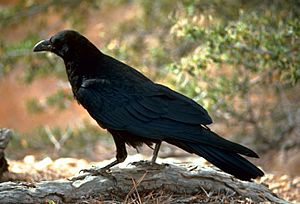Raven paradox facts for kids
The Raven paradox is a tricky idea about logic and how we learn things. A German thinker named Carl Gustav Hempel first talked about it in the 1940s. It's called a paradox because it leads to a conclusion that seems strange, even though it comes from ideas that usually make sense. It makes us wonder how we can truly prove something is true.
What Is the Raven Paradox?
The paradox starts with two simple ideas:
- Idea 1: Equivalent Statements: If two statements mean the exact same thing, then if one is true, the other must also be true.
- Idea 2: Evidence: Seeing an example of something helps prove a general rule about it.
Let's use an example with ravens:
- (1) All ravens are black.
This statement means the same thing as:
- (2) If something is not black, then it is not a raven.
Think about it: If you find a raven that isn't black, then both (1) and (2) are false. If all ravens are black, then anything that isn't black can't be a raven. So, these two statements are logically equivalent. They always go together.
Now, let's look at the second idea about evidence. If you see a black raven, that's good evidence that:
- (3) All ravens are black.
This makes sense, right? Seeing more black ravens makes you more sure that all ravens are black.
The Strange Conclusion
Here's where the paradox gets interesting. If we use the same logic for statement (2):
- (2) If something is not black, then it is not a raven.
What would be evidence for this statement? According to our second idea, seeing something that is "not black" and "not a raven" would be evidence.
Imagine you see a green apple.
- Is it not black? Yes, it's green.
- Is it not a raven? Yes, it's an apple.
So, a green apple is evidence for the idea that "if something is not black, then it is not a raven."
But remember, statement (1) "All ravens are black" and statement (2) "If something is not black, then it is not a raven" mean the same thing!
This means that if a green apple is evidence for statement (2), then a green apple must also be evidence for statement (1) – that "All ravens are black"!
This conclusion feels very strange. How can looking at a green apple tell us anything about the color of ravens? This is why it's called the Raven paradox. It shows how logical rules can sometimes lead to surprising, even confusing, results.
See also
 In Spanish: Paradoja del cuervo para niños
In Spanish: Paradoja del cuervo para niños



